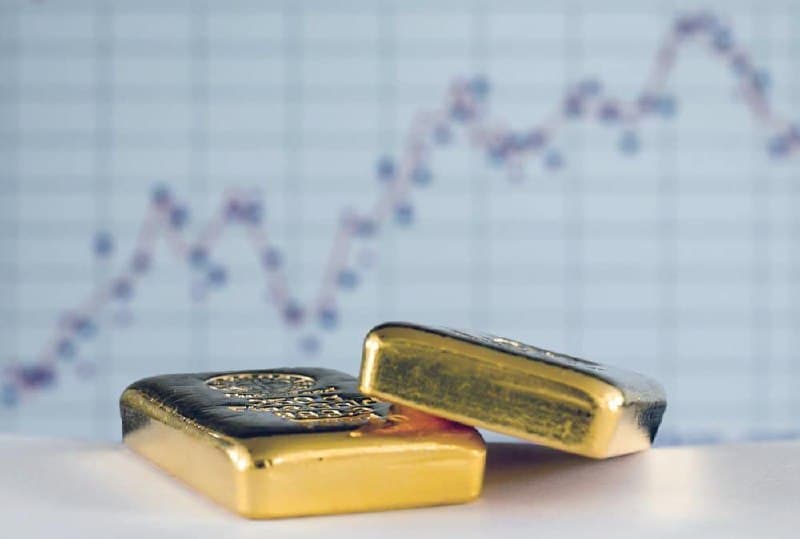Gold, traditionally seen as a safe-haven asset during economic and geopolitical uncertainty, is on a trajectory to reach $3,000 per ounce, according to Mike McGlone, senior commodity strategist for Bloomberg Intelligence.
McGlone’s detailed analysis provides a comprehensive view of the factors driving this bullish outlook, grounded in current market dynamics, economic indicators, and rising geopolitical tensions.
On August 16, gold prices soared to a record high, surpassing $2,500 per ounce for the first time in history. The current price stands at $2,498, reflecting a modest pullback of 0.5%.
The ‘Stair-Step’ rally: Gold’s gradual ascent
In his recent interview with the Market Domination team regarding gold’s price surge in 2024, McGlone describes gold’s current trend as a “stair-step rally,” where the price gradually ascends, establishing solid support levels before moving higher.
This pattern is evident as gold solidifies its position around $2,400 to $2,500 per ounce, signaling a stable, long-term upward trend rather than a volatile spike. This steady climb is further reinforced by gold’s outperformance of the S&P 500 over one, two, and three-year periods, indicating a shift in investor sentiment toward safe-haven assets.
Historical analysis: The S&P 500/Gold Ratio as an indicator
In a recent analysis on X (formerly Twitter) on August 20, McGlone examined the relationship between commodities, particularly crude oil, gold, and the S&P 500 index.
The chart compares the S&P 500/Gold ratio with WTI Crude Oil futures, suggesting that historical patterns may be repeating, with significant implications for global markets.
Historically, the S&P 500/Gold ratio has been a crucial indicator of market sentiment. This ratio measures the relative performance of equities (S&P 500) against gold.
A high ratio typically indicates that equities are outperforming gold, suggesting a risk-on environment where investors favor stocks over safe-haven assets like gold.
The inverse relationship between the S&P 500 and gold is also evident in the chart. During periods of economic stress or uncertainty, the S&P 500/Gold ratio tends to decline as investors flock to gold, seeking safety from market volatility. This was clearly seen during the 2008 crisis and the 2020 pandemic, where gold prices surged as equities tumbled.
The current chart suggests that a similar pattern may be emerging. With the S&P 500/Gold ratio near a potential peak and economic indicators flashing warning signs, such as the US yield curve inversion and economic challenges in China, a shift towards gold could be imminent.
This would likely result in a decline in the S&P 500/Gold ratio, as gold outperforms equities during the next downturn.
Geopolitical factors driving gold’s rise
Geopolitical factors also play a significant role in gold’s rise. The strengthening relationship between China and Russia, described by McGlone as an “unlimited friendship,” is contributing to global uncertainty.
Historically, such geopolitical risks drive demand for gold as investors seek safety, pushing its price upward.
Economic indicators add further support to McGlone’s projection. A rising U.S. unemployment rate, expected to hit 4.5% by September, combined with a steeply inverted yield curve, a common precursor to a recession, enhances gold’s appeal as an investment.
Additionally, ongoing U.S. deficit spending exacerbates economic instability, making gold a more attractive store of value.
While McGlone acknowledges potential short-term risks, such as a sharp stock market decline that could trigger stop-loss orders and temporarily dip gold prices, he remains confident in gold’s long-term upward trajectory.
Upcoming events, including Federal Reserve announcements, the U.S. jobs report, and continued gold purchases by central banks, particularly in China, are likely to serve as catalysts for further price increases.
Potential for gold to reach $3,000
Given the historical patterns observed in the chart, the current economic environment could drive gold prices significantly higher.
If the S&P 500/Gold ratio begins to decline as expected, and investors increasingly seek the safety of gold, prices could surge toward $3,000.
This potential increase in gold prices would be driven by a combination of factors, including rising unemployment, inflationary pressures, and global economic uncertainty.
In conclusion, McGlone’s analysis presents a well-rounded case for gold reaching $3,000 per ounce.
The convergence of strong geopolitical factors, supportive economic indicators, and strategic central bank purchases creates a bullish outlook for gold, solidifying its status as a highly attractive asset in uncertain times.
Disclaimer: The content on this site should not be considered investment advice. Investing is speculative. When investing, your capital is at risk.









